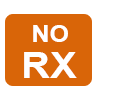Noroxin (norfloxacin)
This medicine is used to treat a lot of bacterial infections. It is a synthetic chemotherapeutic antibacterial agent and can treat many complicated bacterial infections. It is also known as Norfloxacin. It was first introduced in the year 1979 for patent.

Dosage
The dosage of Noroxin (norfloxacin) can vary depending on the specific condition being treated, the severity of the infection, and the individual patient's medical history. It is important to follow the instructions provided by your healthcare provider or the directions on the prescription label.
For most urinary tract infections, the typical adult dosage of Noroxin is 400 mg taken orally every 12 hours for 7 to 10 days. However, the dosage may be adjusted based on the type and severity of the infection.
For certain gastrointestinal infections, such as infectious diarrhea, the recommended adult dosage of Noroxin is 400 mg taken orally every 12 hours for 5 to 7 days.
Composition
It is a spectrum antibacterial agent which is used for oral administration. It is soluble in glacial acetic acid, ethanol, water and methanol. This medicine is available in 400-mg tablets. Each tablet of this medicine contains the subsequent inactive ingredients croscarmellose sodium, cellulose, magnesium stearate, hydroxypropyl cellulose, hydroxypropyl methylcellulose, and titanium dioxide.
Uses
Noroxin is used for the treatment of urinary tract infections, cystitis, urethral, cervical gonorrhea, prostatitis, syphilis, typhoid and paratyphoid fever. It is also used to treat certain infections of the stomach and intestine.
Side Effects
Like all medicines Noroxin is also known to have side effects. Some of the side effects may require immediate medical attention. The degree of the side effects varies from people to people. Some may report minor to no side effects after using this medicine. Some of the common symptoms are:
- Diarrhea
- Headache
- Stomach pain
- Dizziness
- Nausea
- Stomach
- Abnormal heart beats
- Sun sensitivity
- Tendon rupture
- Tendinitis
- Fever

Contraindications
If you have a severe reaction to this medicine, let your doctor know before using this medicine. Any type of allergy should also be reported to the doctor. The doctor will also ask for your medical history to decide if he can prescribe this medicine for you. If you have a slow heartbeat, low level of potassium, nerve problems, seizures, chest pain, myasthenia gravis or blood disorder, make your doctor aware of it. The doctor will only prescribe this medicine if the potential benefits outweigh the risks involved. This medicine can cause interactions with other medicines, hence, if you are using any non-prescription, prescription, or herbal products, let your doctor know asthese medicines can lead to severe reactions or side effects. This medicine can cause dizziness and lightheadedness, so make sure that you do not drive or use heavy machinery, ordo any activity which requires alertness while using this medicine or unless you deem yourself fit enough. Avoid prolonged exposure to sunlight and wear protective clothing and use sunscreen,as this medicine can make your skin sensitive. Call your doctor immediately if you have swollen, or blistered skin due to excessive sunlight.
Pregnancy and Noroxin
The use of this medicine is contraindicated as it can have side effects on the fetus and can lead to abortion. It can also pass into the breast milk and affect the child.
Some frequently asked questions about Norfloxacin
What is norfloxacin?
Norfloxacin is an antibiotic medication belonging to the fluoroquinolone class. It is commonly used to treat various bacterial infections, particularly those affecting the urinary tract and gastrointestinal system.
How does norfloxacin work?
Norfloxacin works by inhibiting the activity of certain enzymes in bacteria, preventing them from replicating and spreading. This helps to eliminate the infection and relieve associated symptoms.
What conditions can norfloxacin treat?
Norfloxacin is primarily used to treat urinary tract infections, including cystitis and pyelonephritis, caused by susceptible bacteria. It may also be prescribed for certain gastrointestinal infections, such as infectious diarrhea caused by specific pathogens.
How is norfloxacin taken?
Norfloxacin is typically taken orally in the form of tablets or suspension. The dosage and duration of treatment will depend on the specific infection, the severity of the condition, and the guidance of your healthcare provider. It is important to take norfloxacin exactly as prescribed and for the entire duration of the treatment.
Are there any side effects associated with norfloxacin?
Like any medication, norfloxacin can cause side effects. Common side effects may include nausea, diarrhea, stomach pain, headache, and dizziness. In rare cases, it may cause more serious side effects, such as tendon rupture or central nervous system effects. If you experience any severe or persistent side effects, seek medical attention.
Can norfloxacin interact with other medications?
Norfloxacin may interact with certain medications, including antacids, iron supplements, and other antibiotics. It is important to inform your healthcare provider about all the medications you are currently taking to avoid potential interactions.
Can norfloxacin be used during pregnancy or while breastfeeding?
Norfloxacin is generally not recommended during pregnancy or while breastfeeding. It is important to consult with your healthcare provider before using norfloxacin in these situations to evaluate the potential risks and benefits.
What should I do if I miss a dose of norfloxacin?
If you miss a dose, take it as soon as you remember, unless it is close to the time for your next scheduled dose. In that case, skip the missed dose and continue with your regular dosing schedule. Do not double the dose to make up for the missed one.
- Download in PDF » Noroxin: Product Information


